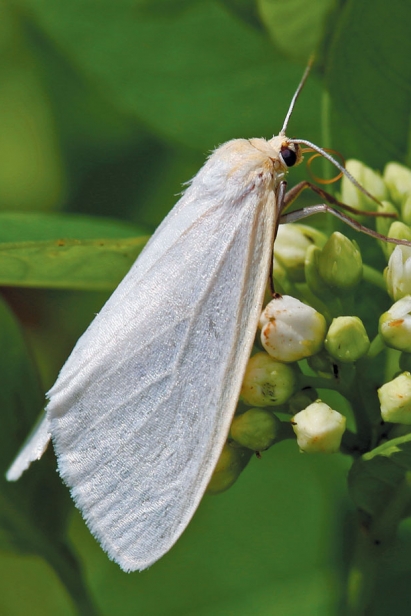Flower Fidelity: Ohio's Pollinators and What to Grow for Them in Your Garden
Did you know some scientists estimate that one out of every three bites of food we eat exists because of animal pollinators like bees, butterflies and moths, birds and bats and beetles? It is a great fact and opens our eyes. Yes, we need, rely on and take for granted the productivity that these variously sized workers do for our food supply. Pollinating plants for our consumption, however, is only one small role these pollinators play in the prairie ecosystem.
Let us draw a picture that focuses on several different pollinator species—moths, beetles and bees. Moths may not be the showiest pollinator that first comes to mind but they are actually, as a family, one of the most efficient pollinators around, just behind native bees. The Dogbane tiger moth (Cycnia tenera) is a daytime flyer that obtains nectar as a food source from a variety of blooming plants, hence the pollination. The moth lays her eggs on the underside of their host plants’ leaves—dogbane and milkweed—for the growing caterpillars to feed on.
Moths then are a key contributor to the survival of native plants in prairies and their caterpillars act as a food source for other species. Moths lay an abundance of eggs in the hopes that some of their offspring survive. Many birds, like songbirds, rely heavily on insects as a food source through all or part of the growing season. Caterpillars provide an excellent source of fat and protein for growing young birds and adults alike. Because the Dogbane tiger moth is a daytime flyer, it pollinates a diversity of native plants, often seen during hikes. Other moth species like the Primrose moth are nocturnal and pollinate flowers that open after dusk, like its namesake, the Evening Primrose.
Moths are cool, but bees are the true muscle when it comes to pollination and affecting the creation of diverse habitats. Many native bees nest below the surface in burrows. Miner bees, for example, excavate long tunnels slightly wider than their own bodies to create protection for themselves and their broods. Their tunnels aerate the soil, encouraging the influx of nutrients and water. This in turn helps create quality soil structure for native plants to grow.
Bees are a well-adapted species that have evolved to work within the ecosystem, increasing both their own survival and the survival of the species that they depend on. Well-aerated soils allow for a diverse array of native plant species to thrive, which then creates food sources for the bees. Bees rely on flowers for food to feed their young, so they actively seek out and visit flowers. Bees will visit one or a few flowering species during each foraging trip. This foraging technique is another adaption focused on helping the productivity of the ecosystem called flower fidelity. The foraging technique ensures pollen from similar species is being transferred within species. Bees are very efficient pollinators!
Beetles are another pollinator found in the prairie ecosystem that do not pollinate on purpose. Pest control is their biggest contribution. For example, the ladybird beetle (Coccinellidae) or the common ladybug, finds its food source, aphids, on native plants as well as agriculture plants. Aphids suck the juices from plant stems and fruits. While ladybird beetles are feasting on aphids they are inadvertently pollinating and protecting the plant’s survival.
Due to development, Ohio has lost more than 90% of its prairies. Pollinator species may have experienced most of this habitat loss, but many other species are dependent on pollinators and the habitat they create. The diverse roles pollinators play create many different habitats for many species of plants and wildlife to thrive. Songbirds, such as field sparrows and eastern bluebirds as well as turkey and bobwhite quail, can be seen nesting and foraging in pollinator habitat. Small mammals also appreciate the cover provided, their movements completely hidden from aerial predators such as red-tailed hawks and American kestrels.
Because of habitat loss and the productivity prairie ecosystems create for diverse wildlife, The Ohio Pollinator Habitat Initiative (OPHI) is working behind the scenes to create diverse, productive pollinator habitats across Ohio. OPHI is a statewide network of diverse partners that work together to provide education, outreach, handson conservation/native seed collections and technical assistance to all who have an interest in pollinators and protecting our food supply.
You can help pollinators by considering their diversity and their diverse needs. This includes planting trees, shrubs, native flowers and native grasses (see sidebar). Creating a diverse landscape allows for pollinators to find multiple resources they need without expending a great amount of energy traveling Ohio’s landscape. Pollinators like the monarch butterfly need as much energy as possible to complete their great migration to Mexico in the fall.
Pollinator areas can be active during the entire growing season. Choose plant varieties that have overlapping blooming periods throughout early spring to late fall. Pesticides should be applied as minimally as possible. OPHI is working with a wide range of people: farmers with the Conservation Reserve Program, members of the public with gardens, businesses like AEP under transmission lines and ODOT to create pollinator habitat along selected roadsides.
Contact us at the OPHI and we’d be glad to have you help.
What to Plant for the Pollinators
For a basic pollinator plot, there are four main points to consider when picking which species to plant to create a pollinator garden; blooming periods, host plants, soil health and the overall diversity. Below is an example of a few species people can plant in their gardens and backyards.
Spring blooming species include golden alexanders, Ohio spiderwort and Western yarrow; provide a diversity of colors, gold, blue and white respectively.
Summer blooming species include blackeyed susan, common milkweed, Oxeye sunflower, wild bergamot and partridge pea. These species provide a diversity of colors and flower shape, while common milkweed acts as our host species and partridge pea as a native legume to help replenish the soils.
Fall blooming species include smooth blue aster, rough blazing star and stiff goldenrod. We also need grass species to provide habitat and help with soil health; prairie dropseed, and little bluestem, are two species that do just this.






